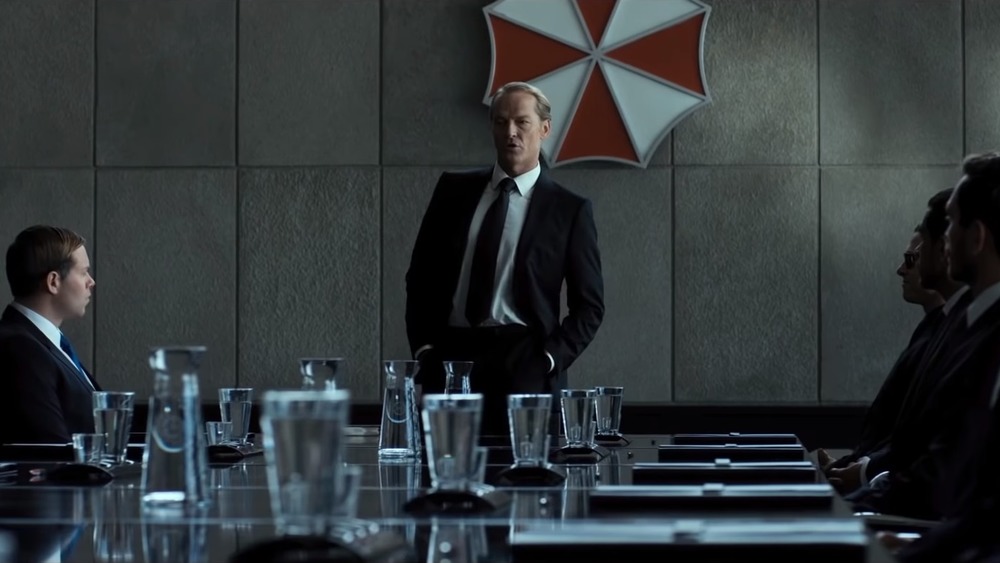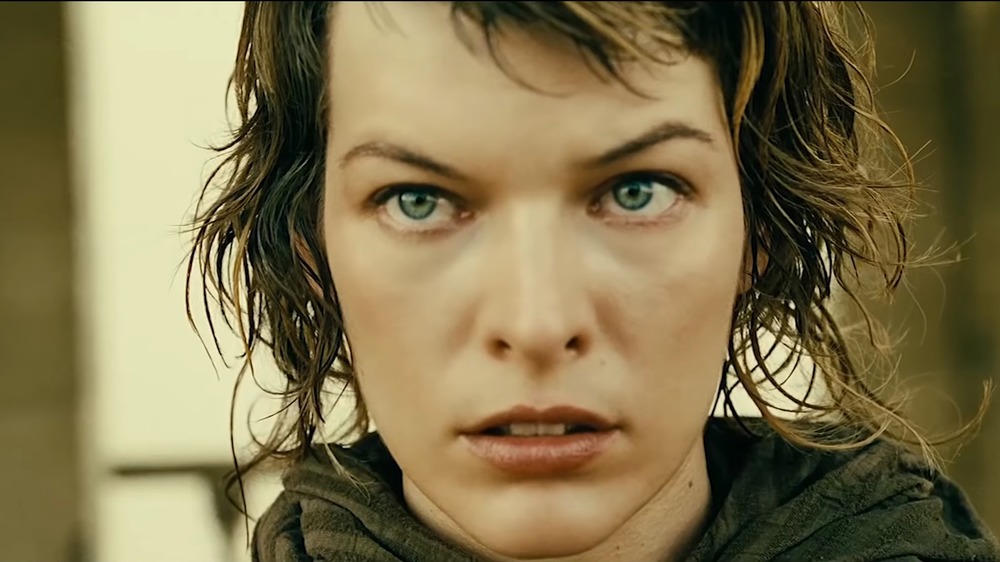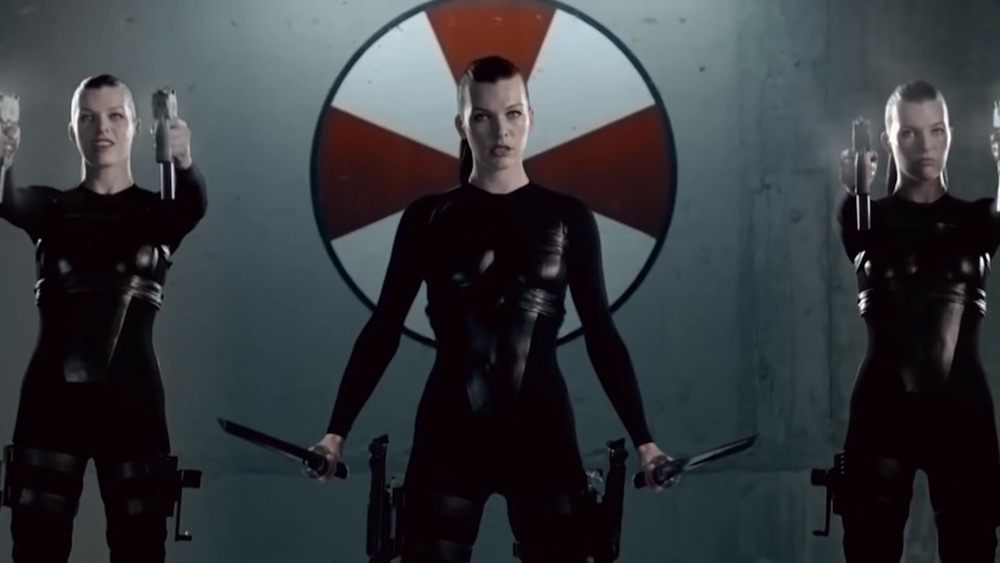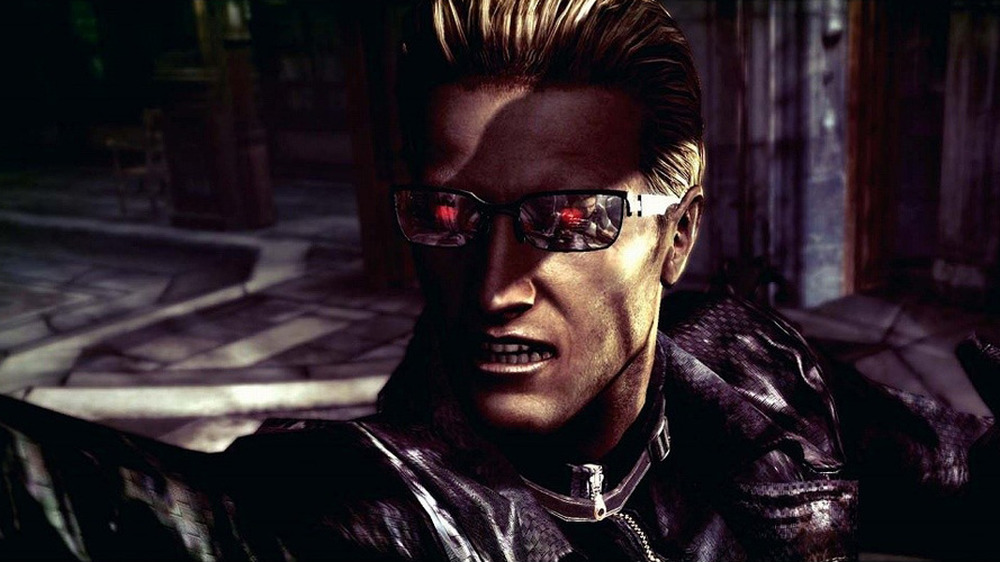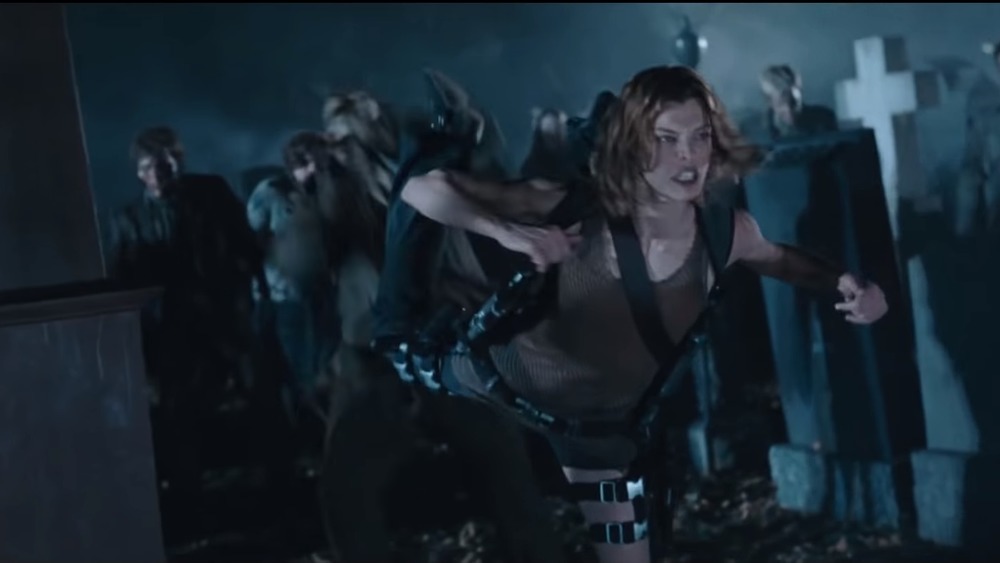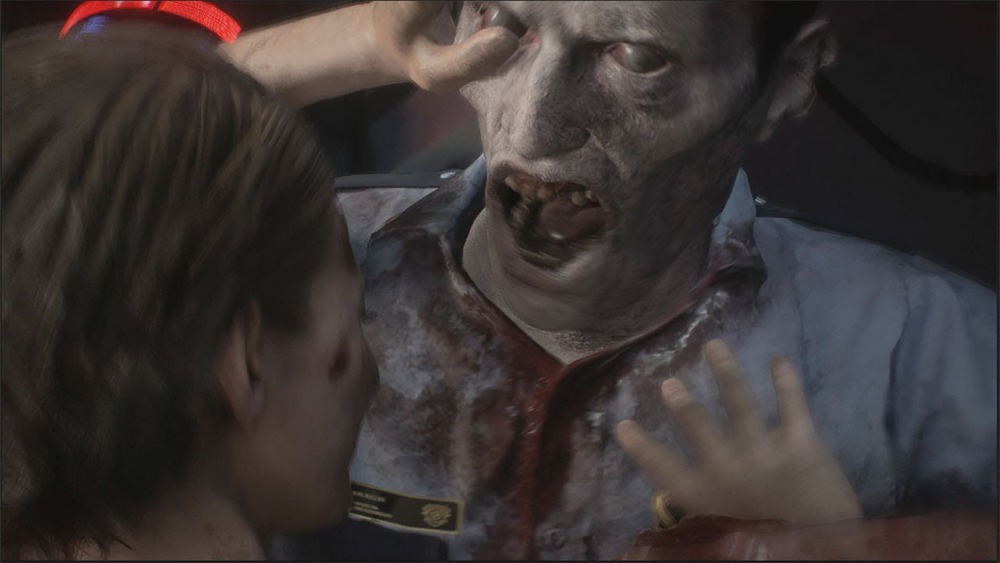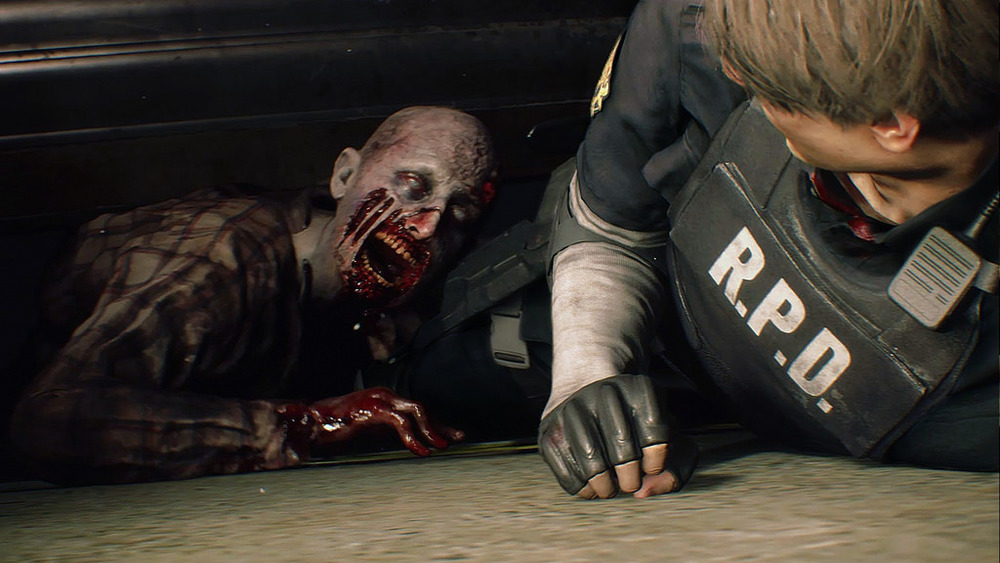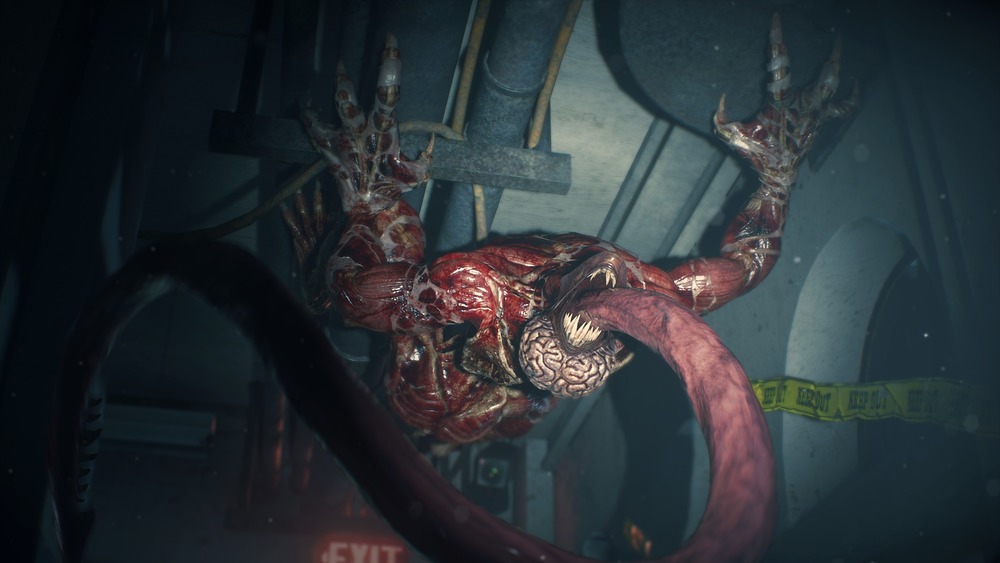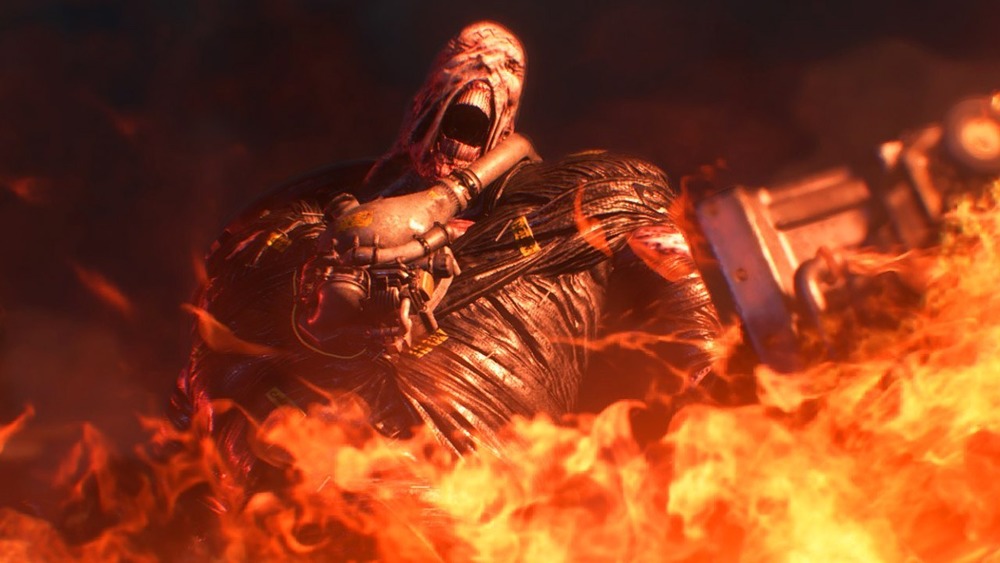Everything The Resident Evil Movies Get Wrong About The Games
The Resident Evil movies are infamous among gamers and moviegoers alike. But the franchise — directed by Paul W.S. Anderson — plays fast and loose with its source material. The movies feature a who's who of famous Resident Evil faces, but they barely resemble their digital counterparts. More importantly, the movie continuity is malleable and important plot points in one movie are forgotten in the next, if not radically altered to fit a new narrative.
Needless to say, the Resident Evil movies get a lot wrong about the video games, from simple ideas like characterizations to semi-complicated aspects such as the iconic t-virus' mechanics. Perhaps if Anderson had made his own zombie movie divorced from Resident Evil, he wouldn't have developed some of the worst video game movie adaptations ever.
At least audiences and critics can now examine how the films both botch the Resident Evil name, and provide an example of how to not adapt a video game into a movie. That said, here are some of the more glaring issues we found in the Resident Evil flicks.
They confuse themselves for House of the Dead movies
The first Resident Evil movie starts off quite promising and features only a handful of zombies (relatively speaking). Sure, they eventually swarm the film's claustrophobic corridors, but they are still just one lab's worth of walking dead, which is on par with the source material. Then the movies jump the t-virus infected shark.
By the third movie, the t-virus spread across the world, devastating the human populace and drowning survivors in a tidal wave of zombies. And, the virus also turned forests into deserts and dried up lakes and rivers. How? In the Resident Evil games, the t-virus is heavily mutagenic. It is supposed to transform plants into giant carnivorous monstrosities, not cause mass evaporation and desertification.
Anderson's version of the t-virus has more in common with the House of the Dead's zombie virus, since in the third and fourth entries, the game world is reduced to a blasted wasteland littered with zombies and giant bosses named after tarot cards. Granted, later Resident Evil games feature outbreaks across the globe, but those are the results of localized terrorist attacks, not a worldwide pandemic.
Resident Evil is supposed to be about resident horror, not apocalyptic horror. It's in the name, after all.
The cause of the Raccoon City outbreak is simplified a little too much
The source of a zombie outbreak is half the genre's fun. What caused the plague in the first place? A mutant ebola virus? Cordyceps? Bees? While the Resident Evil movies get the viral origins correct, they botch almost everything else, including the legendary Raccoon City incident.
In the games, the Raccoon City outbreak is the result of a convoluted conspiracy web involving a giant leech that wants to destroy the Umbrella Corporation (long story), as well as scientists Albert Wesker and William Birkin defecting from Umbrella. Later, Birkin destroys t-virus containers, which infect sewer rats that swim to a nearby lake. Since the lake is Raccoon City's water supply, everyone in the city unknowingly drinks t-virus water, and bam, zombie outbreak.
The movies, meanwhile, feature a watered-down conspiracy. Two people want to expose Umbrella's illegal activities, but a guard overhears them and decides to sell a t-virus sample on the black market before finding a potential buyer. And, to be a jerk, he also infects the Umbrella lab with the virus. How does the virus spread to Raccoon City? Someone left the lab door open and let zombies wander out.
In the games, the Raccoon City incident was caused by a war of egos. In the movies, it was caused by a lack of common sense.
Insane genesiologists and war profiteers
On the surface, the Umbrella Corporation is a family-focused pharmaceutical company that creates everything from diet noodles to first-aid spray, but once you scratch its surface, you discover a world of unethical testing and bioterrorism. But why is Umbrella the worst company since LexCorp? The video games and movies have two different answers.
In the Resident Evil games, Umbrella was founded on the premise of eugenics. The company and its founders want to burn the world down and replace it with a new, virus-enhanced one. If Dr. Ian Malcolm was in the world of Resident Evil, his wise words of wisdom would be lost on the company.
The Umbrella Corporation of the movies, however, is a completely different beast that can't keep a solid mission statement. In some films, Umbrella is a stereotypical greedy company that wants profit from biological warfare weapons contracts. Other times, it hopes to domesticate zombies. And in the series' final chapter, Umbrella plans to destroy the world and restart from scratch so humans — not virus-enhanced humans, mind you — can live in peace.
The Umbrella of the films' plans change more frequently than a stop light, while the Umbrella of the games is consistently dedicated to a "better" world as defined by an outdated, demonstrably evil worldview.
Who is Alice?
One would assume the Resident Evil movies star numerous RE characters since the video game franchise has a huge well to draw from. Granted, the series is full of fan-favorite characters, from boulder-punching beefy boy Chris Redfield to the master of unlocking Jill Valentine. While the movies feature plenty of game characters, they all take a backseat to the star of the show, Alice.
If you've never watched a Resident Evil movie, you might just be wondering who the hopping Hunter Alice is. Is she the long-lost "sister" of Albert and Alex Wesker? Nope. What about a movieverse version of an existing character with an altered name? Nuh-uh. Alice is nothing more than Anderson's original character, and she is basically infallible.
Since Alice is designed to be perfect in every way to show off actress Milla Jovovich, she steals the spotlight from literally every RE protagonist in the films. For example, Resident Evil: Apocalypse is essentially an adaptation of Resident Evil 3, so you would expect the movie to star Jill Valentine. She's in the movie, but she plays second fiddle to Alice. At least Alice doesn't show up in the CG Resident Evil movies.
Alice takes t-virus down the rabbit hole in the wrong direction
Longtime Resident Evil fans know the t-virus is a horrible mutagenic pathogen that plays musical chairs with DNA. However, the movies don't understand this and portray the virus as a deus ex machina that does whatever Anderson wants, especially when it comes to Alice.
Normally in the games, the t-virus results in creating mindless zombies at worst and the iconic Tyrant — the "t" in t-virus stands for Tyrant — at best. Granted, the t-virus gave Albert Wesker superhuman speed and strength, but he also got red eyes, lost all empathy, and couldn't maintain his strength without a special serum. But in the movies, Alice is injected with the t-virus and gains all of Wesker's powers without any drawbacks. Moreover, she acquires telekinesis. Wait, what?
While some people in Resident Evil video game canon obtain unique powers through the t-virus, telekinesis is not on the available abilities list. Some can hurl combustible blood, but telekinesis? In a zombie game? In House of the Dead, sure, but not RE. The closest the Resident Evil games have to telekinesis is invisible zombies, but those are in a bonus game mode and are not canon.
Resident Evil might feature fantastical elements like zombie plagues, but it keeps those aspects grounded in reality without far-fetched ideas like telekinesis. At least, the games do.
They completely botched Wesker
Albert Wesker is the primary antagonist of the Resident Evil franchise. Every outbreak, every machination, and every character ties back to him. However, the movies don't understand his importance.
In the games, Wesker was the brainchild of one of Umbrella's many eugenics programs, but the Spencer Mansion incident convinced him to cut ties with the company. You see, his t-virus mutation gave him a God complex that made him view everything and everyone as disposable pawns. Even though Wesker shares Umbrella's vision of a perfect, virus-enhanced world, he wants to fulfill that goal on his own terms and rule the new world by himself.
The movie's Wesker, however, changes from film to film with one crucial difference: He is always loyal to Umbrella. Usually, Wesker is the chairman of Umbrella and bosses around Anderson's other RE original character Dr. Alexander Isaacs. Even when Wesker betrays Umbrella in one film, the next movie reveals it was all a ruse. And, in Resident Evil: The Final Chapter, Wesker is surprisingly subservient to Dr. Isaacs. Gone is the superpowered megalomaniacal maniac gamers love to hate, replaced by another lip service character who plays second fiddle to Anderson's headcanon.
To quote Wesker, "How disappointing."
To all the zombies, I bequeath a boot to the head
How does someone kill a zombie? Usually, you just destroy the brain or sever the neck. This remains true for zombies in the Resident Evil games, as much of the franchise's horror comes from struggling to nail headshots while maintaining enough ammunition to deal with other monsters. The series actively encourages players to run away since zombies tend to outnumber bullets. The movies, however, have their own ideas on how to kill zombies — ideas that fly in the face of zombie survival 101.
The Resident Evil movie franchise is full of examples where zombies are put down with melee attacks. A kick to the head that doesn't even shatter the skull? That lays a zombie out. Breaking/dislocating an arm? That wouldn't slow down most zombies, but in the movies it kills them dead.
Most pieces of zombie media, including Resident Evil games, will tell you that melee is a bad idea since it gives zombies the perfect opportunity to turn a buffet of fists into an all-you-can-eat buffet. But, the RE movies ignore this piece of common sense since punching zombies into submission makes about as much sense as actual zombies.
That's not how zombification works
What are zombies? Depending on the story, they can be still-living, brainwashed victims of voodoo sorcery, actual corpses resurrected through necromancy, or semi-living hosts of a virus or parasite. Zombies in the Resident Evil games fit squarely in the final category, but occasionally the movies forget this and break their own continuity. Then again, continuity and the RE movies aren't on speaking terms.
In Resident Evil: Apocalypse, the main characters try to escape Raccoon City and make their way through a graveyard, at which point zombies burst from the ground to attack them. These creatures raise the question of how they can move since they were clearly buried before the t-virus outbreak occurred, so they couldn't have been infected by the virus. If they aren't t-virus zombies, how in Dr. Salvador's rusty chainsaw are they moving? Are they actual necromantic zombies? The movie holds no answers.
To be fair, the c-virus in Resident Evil 6 can resurrect long-dead corpses, but they have to be well preserved. Plus, Apocalypse came out in 2004 and RE6 in 2012, so Anderson couldn't have drawn inspiration from the game since it didn't exist yet. This violation of RE lore has more in common with Return of the Living Dead's Trioxin than any RE game.
Why would you cure paraplegia with a zombie plague?
The origins of a zombie virus are either the result of illegal experiments or nature gone awry. Under no circumstances should zombie plagues be associated with altruism, but the Resident Evil movies never got the memo.
The Umbrella Corporation of the Resident Evil games is a longstanding proponent of eugenics, and the t-virus was created to further the goal of a "perfect" world. Of course, the company needed revenue to fund this post-apocalypse utopia, so it created Bio Organic Weapons (B.O.W.s) with the t-virus and sold them to terrorists. Umbrella always knew the t-virus only creates monsters and gladly used it to spit in God's eye. The Umbrella of the movies, however — not so much.
Depending on which movie you watch, the t-virus has one of two inventors. According to Resident Evil: Apocalypse, the virus was created by Dr. Charles Ashford to help his daughter walk again. But fast forward to Resident Evil: The Last Chapter and history is flipped. Umbrella co-founder James Marcus discovered the t-virus could potentially cure his daughter's progeria. Regardless of origins, though, the t-virus still turns humans into zombies.
Somewhere along the line, someone forgot to engage in peer reviewed testing since there is a huge gap between "curing diseases" and "creating zombies." The gap between "making zombies" and "eugenic utopia," however, is not as wide.
They couldn't even get the Lickers right
When you think of creatures synonymous with the Resident Evil franchise that aren't zombies, your mind probably leaps to the Tyrant and the Licker. While the latter appears in the first Resident Evil movie and became a staple of the library, Anderson doesn't fully understand what makes the Licker terrifying.
At first glance, the Licker is the product of rogue science. The creature looks like a tube-grown abomination with a quadrupedal gait, giant claws, an exposed brain, and a long, lashing tongue. However, Lickers are truly horrifying because they were once standard t-virus zombies. Apparently, if one of these zombies is riddled with bullets but keeps its brain, it hibernates and the t-virus goes into overdrive, healing and mutating it. The Licker is the end result.
The Lickers in the movies, unfortunately, are more mundane. Sure, they are still living, skinless horrors with long tongues and exposed brains, but instead of resulting from the t-virus gone berserk, they are just people who were injected with the virus while alive. Also, they mutate whenever they eat.
Simply put, the movies diminish the Lickers. The knowledge that "killing" a zombie without destroying its brains will unintentionally result in Lickers (or Crimson Heads) is far more nightmare-inducing than knowing they were deliberately created.
Game accuracy is the movie franchise's Nemesis
Ah, Nemesis– the lovechild of the Tyrant from the first Resident Evil game and the T-800 Terminator. This creature might have a vocabulary of one word, but it's still terrifying, at least in the games.
Initially, the Nemesis looks like yet another of Umbrella's Tyrants, but the creature is slightly more complicated. While the main body is indeed a Tyrant (specifically a T-103), its brain is controlled by a Nemesis α parasite. The resulting symbiosis features all the strength, resilience, and regeneration of a Tyrant, but with the intellect of a human and — to make it more creepy — tentacles.
The Nemesis from the movie, however, is far less impressive.
Anderson's version of the Nemesis is a single, human-sized monster that's stronger and smarter than a zombie, but not by much. Even though this version walks through many members of Special Tactics And Rescue Service (S.T.A.R.S.), Alice still eventually defeats it in a boxing match. Then it betrays Umbrella. And the kicker? Nemesis is just a heavily mutated person who was scratched by a Licker. It is essentially a rando who won the genetic lottery jackpot — or lost it, depending how you look at things.
Las Plagas, less sense
Capcom took a huge risk when it abandoned the t-virus and zombies in Resident Evil 4 and replaced them with Plagas and the Ganados. However, the gamble paid off, and Plagas returned in Resident Evil 5, this time with a new host army, the Majini. Anderson clearly liked Plagas and wanted them in his Resident Evil movies, but he botched their backstory.
In Resident Evil 4 and 5, Plagas are unrelated to the t-virus and predate it by a wide margin, even though they turn their hosts into zombies. More importantly, the Los Illuminados cult — an obvious reference to the Illuminati — discovered Plagas and used them to create the Ganado army. Eventually, the pharmaceutical conglomerate TRICELL engineered their own Plagas to create the Majini. Why didn't Umbrella join in on the Plagas parade? By this point, it was dead and buried.
Nevertheless, in the movies, Umbrella used the t-virus to create Plagas. Plus, the movies have two kinds of Plagas: a base strain that creates Majini zombies (not Majini) and an improved version that grants its host Wolverine levels of regeneration with no physical or mental repercussions. A far cry from what actually happens when Plagas make their hosts nigh immortal.
Apparently, you're guaranteed super powers with no downsides in the RE movies if you are a woman and inject yourself with a virus/parasite. Monstrous B.O.W. ladies? Never heard of them!
Ada Wong? More like Ada wrong!
Few Resident Evil game characters are as memorable as Ada Wong. She is the franchise's international woman of mystery. Nobody knows her past, real name, or motives. And everyone is too busy surviving zombie attacks to find out. The only known facts about Ada are she's a spy, she knows how to kick zombie butt, and she likes Leon Kennedy. Ada's femme fatale persona, paired with her mysterious past, launched her into the hearts of RE game fans like a crossbow bolt into a zombie brain. However, like many things Resident Evil, the movie version is a shadow of its source material.
Ada Wong only appears in Resident Evil: Retribution. In that movie, she's a cold, business-first ex-Umbrella agent working for Albert Wesker, devoid of the characteristics that made the original popular. However, you might wonder why she appeared in only one movie. One second she was a character in Retribution, the next she was seemingly retconned out of existence. While the final Resident Evil movie never explains this inconsistency, its novelization reveals that a blob-like B.O.W. killed her. Yes, a B.O.W. killed one of Resident Evil's best zombie survivalists. Talk about a figurative and literal character assassination.




